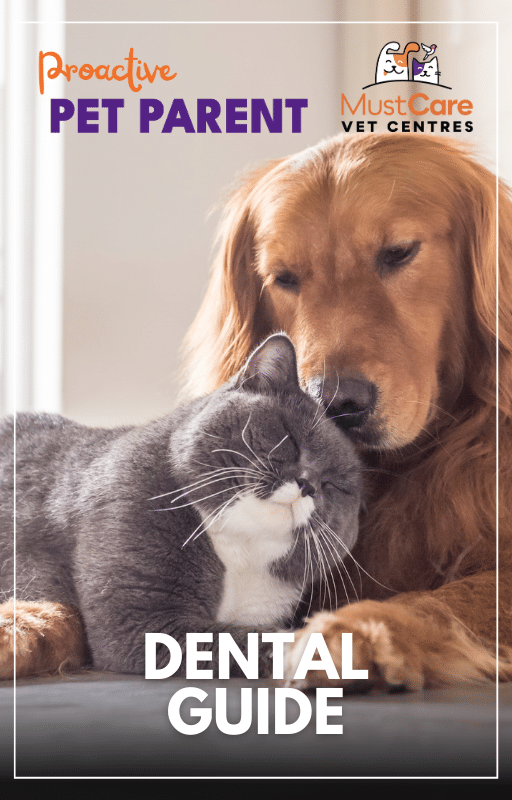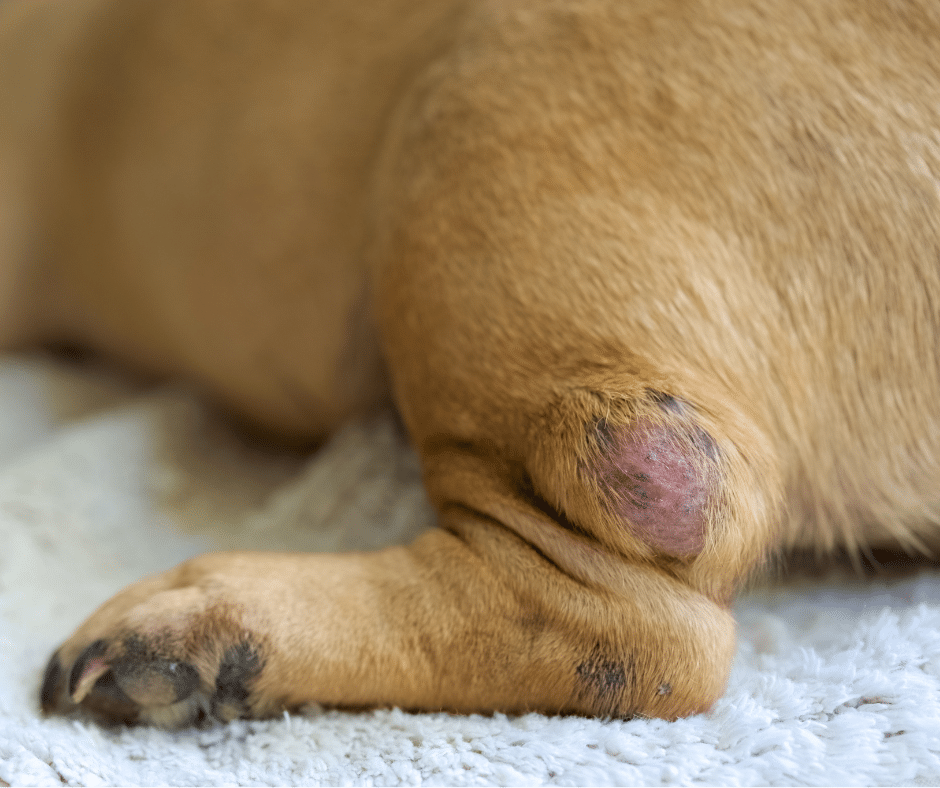Share This Blog With Other Pet Parents!
Identifying Pet Lumps: Benign vs Malignant and Treatment Options
Finding a lump on your pet can be worrying. If you’re wondering if a lump is serious, and if you should be concerned, this article is for you. Understanding the nature of these lumps is crucial in understanding the next steps for your pet’s health and well-being.
This comprehensive guide delves into the types of lumps that can appear on pets, distinguishing between benign and malignant growths, and explores the various treatment options available. This article aims to demystify the topic of pet lumps, providing pet owners with the knowledge to take the next step.
What you’ll learn from this blog:

For all you need to know, download our
FREE Dental Guide
This blog is part of our Proactive Pet Parent series! This is just the beginning… To see more blogs, click here! Better yet, sign-up to our newsletter to receive these directly to your inbox each month.
Sign-up To The Proactive Pet Parent Newsletter
Discovering a lump on your pet can be an unsettling experience. Lumps, varying in size and texture, can appear anywhere on your pet’s body, and understanding their nature is key to ensuring your pet’s health. This guide serves as an essential tool for pet owners, providing clear and accurate information about the different types of lumps that can develop on pets. While some lumps may be harmless, others could signify more serious health issues. It’s crucial for pet owners to be informed about the potential implications of these growths. This article aims to demystify the topic of pet lumps, offering insights into their types, potential causes, and what they could mean for your pet’s overall well-being. By understanding these aspects, you can make informed decisions and take timely action, ensuring the best possible care for your companion.
Types of Lumps in Pets
When it comes to the types of lumps that can appear on pets, the variety is as wide as it is significant. Understanding these types can help in early identification and appropriate response.
Cysts
Firstly, cysts are among the most common types of lumps found in pets. These fluid-filled sacs are generally benign and can appear anywhere on the body. Cysts might feel soft and movable under the skin, and while they are usually harmless, they can become troublesome if they rupture or become infected.
Warts
Warts, another type of lump, are typically small and rough-textured. Caused by a virus, they are more common in younger and older pets, whose immune systems are less robust. Warts can appear in clusters or as a single growth and are often found on the mouth or paws.
Abscesses
Abscesses are lumps resulting from infection, often appearing rapidly and feeling warm and painful to the touch. They can occur from a bite, scratch, or any skin penetration, leading to a buildup of pus under the skin. Abscesses require prompt veterinary attention to prevent the spread of infection.
Tumors (Benign and Malignant)
Lastly, tumors are growths that can be benign or malignant. Benign tumors are usually slow-growing and don’t spread to other body parts. Malignant tumors, however, are more aggressive and can metastasize, necessitating immediate medical intervention.
It’s vital to have any new lump checked by a veterinarian, as early detection plays a key role in effective treatment and management.
Diagnosing Lumps in Pets
When a pet owner discovers a lump on their pet, the first step is to approach the situation calmly and methodically. Begin with a gentle self-examination of the lump. Note its size, shape, and location, and whether it appears to be attached to the underlying tissue or moves freely. Observe any changes in color, temperature, and whether it seems to cause discomfort to the pet. Keep a record of these observations, as they can be crucial for the veterinarian’s assessment.
The next critical step is to consult a veterinarian. Even if the lump seems small and harmless, a professional evaluation is essential. The veterinarian will conduct a thorough examination, which may include palpation, measuring the lump, and possibly performing diagnostic tests like fine-needle aspiration, biopsy, or imaging tests such as ultrasound or X-rays. These tests are vital in determining the nature of the lump and the best course of action.
Pet owners should not delay veterinary consultation, especially if the lump is rapidly growing, changing, or causing discomfort to the pet. Prompt diagnosis is key to effective treatment, particularly if the lump is malignant. The veterinarian can also guide pet owners on monitoring techniques and schedule regular follow-ups to keep track of any developments.
Understanding what to do when discovering a lump can make a significant difference in a pet’s health. Timely action, coupled with professional guidance, ensures that pets receive the care they need and pet owners have peace of mind.
Treatment Options for Pet Lumps
The treatment of lumps in pets depends on several factors, including the type of lump, its location, size, and the overall health of the pet. For benign lumps like lipomas or sebaceous cysts, treatment may not be immediately necessary unless they cause discomfort, hinder movement, or are prone to infection. In these cases, surgical removal is often the recommended option. This procedure is typically straightforward and can often be performed under local anesthesia, depending on the lump’s size and location.
For malignant lumps, the treatment approach is more aggressive. Surgery is usually the primary treatment, aiming to remove the entire tumor along with some surrounding tissue to ensure all cancerous cells are eliminated. In some cases, chemotherapy or radiation therapy may be required, especially if there’s a risk of the cancer spreading. These treatments can be effective in managing the disease and prolonging a pet’s quality of life.
Other treatment options include cryosurgery, where the lump is frozen and destroyed, or laser therapy, particularly for surface lumps. The pet’s age, overall health, and tolerance for specific treatments are crucial considerations in deciding the best course of action.
Veterinarians also play a key role in guiding pet owners through the treatment process, providing information on what to expect and how to care for their pet post-treatment. Regular follow-ups and monitoring are essential to ensure the pet’s health and well-being post-treatment.
Choosing the right treatment for a pet lump requires a balanced approach, considering the pet’s comfort and quality of life alongside the medical necessities.
Preventive Measures and Regular Check-ups
Preventive care plays a pivotal role in maintaining a pet’s health and well-being, especially in the context of detecting and managing lumps. Regular veterinary check-ups are fundamental, as they allow for early detection of any unusual growths or changes in the pet’s body that may not be immediately apparent to the owner. These check-ups often include a thorough physical examination, which can reveal lumps or abnormalities that require further investigation.
Pet owners can also play an active role in their pet’s health by regularly examining their pet at home. This includes feeling for any new lumps or changes in existing ones, noting changes in the pet’s behavior or appetite, and monitoring for any signs of discomfort or pain. Being familiar with their pet’s normal body condition helps owners quickly identify anything out of the ordinary.
Additionally, maintaining a healthy lifestyle for pets is crucial. This includes providing a balanced diet, ensuring regular exercise, and avoiding exposure to known carcinogens. Pet owners should also be aware of their pet’s breed-specific risks, as some breeds are predisposed to certain types of tumors or health issues.
Education about the potential risks and signs of health issues in pets is also essential. Many veterinary clinics offer resources and advice on how to keep pets healthy and what symptoms to look out for. By combining regular veterinary visits with proactive at-home monitoring and a healthy lifestyle, pet owners can significantly contribute to the early detection and management of lumps in pets.
Next Steps
Understanding and managing lumps in pets is a vital aspect of responsible pet ownership. While the discovery of a lump can be concerning, knowledge and prompt action are key to effectively addressing these issues. Not all lumps are cause for immediate alarm, but they do warrant attention and should be evaluated by a veterinarian. Building and maintaining a strong relationship with your veterinarian is crucial. They are your allies in ensuring the health and happiness of your pet. Regular check-ups, open communication, and following their expert advice will go a long way in keeping your pet healthy.
Take heart in knowing that advancements in veterinary medicine offer effective treatment options for various conditions, including lumps. By staying informed, attentive, and working closely with your veterinarian, you can ensure the best possible care for your pet.

